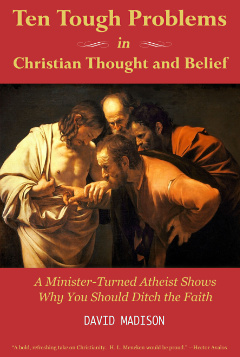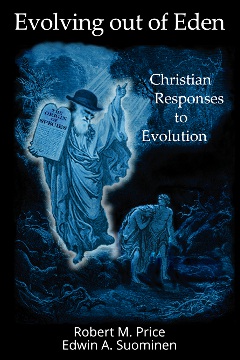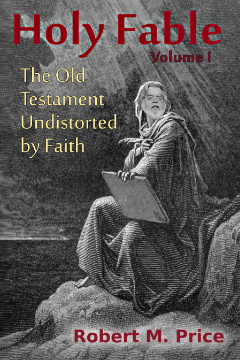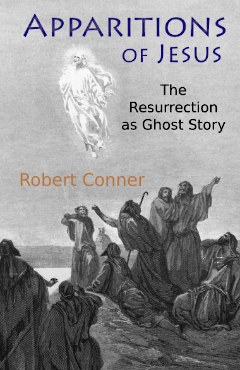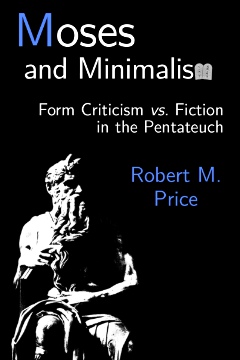Overview: Evolving out of Eden
The layout of Evolving out of Eden centers around three main “branches” of theological conception that are each profoundly impacted by evolution:
I: The Word (the Bible) that was produced by human beings,
II: The Creature (Homo sapiens) who wrote and now expounds on the Word,
III: The Creator, whose recognition and appeasement is the ultimate object of Christian theology.
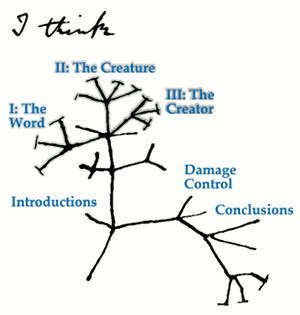
Before reaching the first of those branches, the book begins with a series of introductions: to the book’s tree-branch layout itself, to the overwhelming evidence for evolution, and to the various advocates of theistic evolution who are trying in their own ways to accommodate Christian theology with scientific reality. It also introduces readers to the co-authors, Dr. Robert M. Price and Edwin A. Suominen.
Coming from very different religious and education backgrounds, Bob and Ed teamed up to produce what Tom Flynn, editor of Free Inquiry magazine, calls an “unprecedented . . . joint effort by a theologian and a highly accomplished engineer, both former Christian believers,” to analyze and develop “the theology and the science behind more than a century of Christian responses to the challenge posed by Darwinian evolution.”
The book’s second chapter introduces its co-authors and the way that genetic algorithms, a useful engineering tool, got one of them to finally look seriously at evolution. Then it goes on to discuss some of the prominent writers in the evolution-vs-theology arena.
Here’s the start of the chapter, with an aside to give you a little more feel for how powerful it was to evolution simulated right there on the computer.
Cast of Characters
We are writing primarily about the ideas of others: first the Bible writers who took their best shot at origins and a theology based on it, then those who found themselves having to wrestle with what that Bible had imposed on them. There’s quite a cast of characters here, and it’s only fair that we begin by introducing ourselves.
Your Escorts Out of Eden
This book began as a collaboration between an atheist, Robert M. Price, and a believing but troubled Christian, Edwin A. Suominen, who was wrestling with what he perceived as a grave conflict between evolution and his inherited faith. Having both accepted the reality of evolution (with considerable reluctance on Ed’s part), we agreed to research its theological implications and the various ways that Christian writers have tried to smooth things over.
We set out to evaluate the various approaches with an open mind, and we like to think we were in a pretty good position to be objective about it all. Bob has long since left Christianity (except for occasional participation in the aesthetics of Episcopalian services) yet still retains a love and respect for it as well as the Bible on which it is based. The perceived failure of Christian theology to deal realistically with evolution was not a factor in his respectful departure from Christian belief. Indeed, he did not then see it as a major difficulty.
On the other hand, Ed began the project in the middle of a faith crisis that had been sparked by the realization that evolution was true and Genesis was not. He genuinely wanted to know if there was any convincing solution to what he suspected was an intractable problem for the Christianity to which he still clung, ever so tenuously. That crisis has ended, and Ed has departed his fundamentalist Christianity for reasons that include but are not limited to the evolution issue (see Suominen 2012). So, apart from some remaining tendencies toward Deism on Ed’s part, neither of your co-authors retains any dogmatic commitments to the success of any of the proposed theological solutions we review.
Could that also make us predisposed to criticize and reject those solutions? We hope not, but nobody is really free of bias. Robert Burton has made a fascinating study of the brain’s seemingly unavoidable over-reliance on a subjective “feeling of knowing” the truth of matters not really known. He memorably observes, “Our mental limitations prevent us from accepting our mental limitations” (2008, 1490).
The best any of us can hope for, Burton says, is “partial objectivity” (loc. 1478). Well, so be it. At the risk of sounding like the Pharisee who looked down his nose at the poor publican alongside him in the temple, we note that there is an awful lot of presuppositional thinking out there driving the discussions about evolution and human origins. Creationists relentlessly defend Genesis with viewpoints and arguments that range all across the spectrum of absurdity, seemingly oblivious of modern science. Meanwhile, the sophisticated theologians blaze their various trails outside Eden with a shared motivation to wind up at the foot of the old rugged cross, no matter what. Divided as they all are in their approaches, even between creationism and evolution itself, they still unite in just knowing that their beloved Christianity is true. It’s hard for any attempt at objectivity to compete with “felt knowledge,” whose power “cannot be underestimated, even when it exists independently of reason or any confirming evidence” (loc. 1288).
A Bit of Biography
From 1965-1972, Bob was involved in a fundamentalist Baptist church. He went on to become a leader in the Montclair State College chapter of the Inter-Varsity Christian Fellowship. Having developed a keen interest in apologetics (the defense of the faith on intellectual grounds), Bob went on to enroll at Gordon-Conwell Theological Seminary, where he received an MTS degree in New Testament. Billy Graham was the commencement speaker.
It was during this period, 1977-78, however, that Bob began to reassess his faith, deciding at length that traditional Christianity simply did not have either the historical credentials or the intellectual cogency its defenders claimed for it. Embarking on a wide program of reading religious thinkers and theologians from other traditions, as well as the sociology, anthropology, and psychology of religion, he soon considered himself a theological liberal in the camp of Paul Tillich. He received the Ph.D. degree in systematic theology from Drew University in 1981.
After some years teaching in the religious studies department of Mount Olive College in North Carolina, Bob returned to New Jersey to pastor First Baptist Church of Montclair, the first pastorate, many years before, of liberal preacher Harry Emerson Fosdick. Bob soon enrolled in a second doctoral program at Drew, receiving the Ph.D. in New Testament in 1993. These studies, together with his encounter with the writings of Don Cupitt, Jacques Derrida, and the New Testament critics of the Nineteenth Century, rapidly eroded his liberal Christian stance, and Price resigned his pastorate in 1994. A brief flirtation with Unitarian Universalism disenchanted him even with that liberal extreme of institutional religion.1
Evolution hasn’t been a major focus in Bob’s studies, but a few of his published works do address the issue: “The Return of the Navel: The ‘Omphalos’ Argument in Contemporary Creationism,” Creation Evolution Journal 1, no. 2, 26-33 (Price 1980); Inerrant the Wind (Price 2009, 24-28); “Apex or Ex-Ape?” The Humanist, Jan./Feb. (Price 2010). His New Testament work can be found in books including The Widow Traditions in Luke-Acts (1997), Deconstructing Jesus (2000), The Incredible Shrinking Son of Man (2003), The Pre-Nicene New Testament (2006), and The Amazing Colossal Apostle (2013). His theological works include The Reason Driven Life (2006) and Beyond Born Again (2008).
For his part, Ed makes no pretense of having any professional credentials regarding either theology or evolution. (His education is a Bachelor’s in Electrical Engineering–University of Washington, 1995–and the unfortunate history of engineers advocating for creationism is duly noted.) Ed’s major qualification for this project was simply a passion for it, after experiencing the sting of evolution’s impact on a cherished Christian faith. He is an amateur–a person whose pursuit of a field arises solely from “the love of it,” amatorem–and proud of it.
A Fundamentalist Bumps into Darwin
A few years back, after spending his whole life up to that point in a fundamentalist Christianity where even theistic evolution had been called “an outrage to the word of God” (Reinikainen 1986), Ed got introduced to Darwin in a most unexpected way. He certainly wouldn’t have gone out looking to meet him, having been indoctrinated against evolution to the point where it was almost difficult to say the word without negative connotations. It all began from some research about an intriguing way of optimizing design parameters without the engineer having to explicitly specify those parameters: genetic algorithms.2
It’s one form of evolutionary computation, which, as Daniel Ashlock describes in his textbook on the subject,
operates on populations of data structures. It accomplishes variation by making random changes in the data structures and by blending parts of different structures. These two processes are called mutation and crossover, and together are referred to as variation operators. Selection is accomplished with any algorithm that favors data structures with a higher fitness score. [Ashlock 2006, 13]
Sounds innocuous enough, right? But it’s evolution, plain and simple: the “ability to produce new forms, in essence to innovate without outside direction other than the imperative to have children that live long enough to have children themselves.” That, says Ashlock, is the key feature that evolutionary computation tries to reproduce in software (p. 13), and he spends another 500 or so detailed pages showing the various ways it’s been done.
After reading about evolutionary computation and playing around with demonstrations of it for a while, using readily available open-source software, Ed was soon hooked on its elegance and power. The software sets up an artificial chromosome with each “gene” determining a parameter for some widget you want to design. Then you run a simulation of your widget a few hundred different times, with different sets of parameters specified by random numbers in the genes of each chromosome. Each simulation produces a “fitness” metric, a value that shows how well the widget works in its simulated environment with the particular “DNA” that it was randomly assigned as a starting point.
About what you’re reading
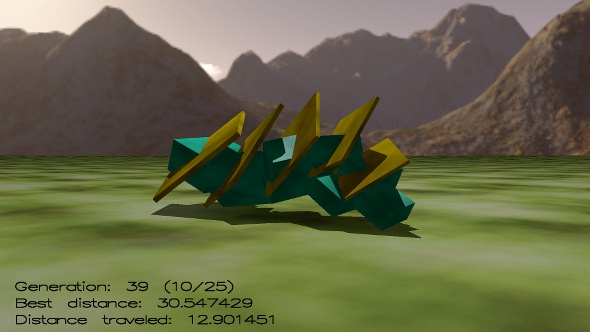
The creature in this image (not part of Evolving out of Eden) is an example of what Ed saw during these investigations. The screenshot was taken (with a bit of visual touch-up) from the Breve open-source evolution simulation software after running on his computer for a while.
The software had generated random variations in individual block creatures and then selected some for the next generation, based on the sole attribute of how far they could go in a given time.
After watching many pathetic mutants twitching motionless and flailing useless appendages around, Ed started seeing a few evolve impressive abilities of forward motion, with no design input from him or anyone else. After 39 generations, this was one of them, with a twisting body that leveraged its square plates against the “ground” to push itself along efficiently.
Then the fun starts: The widgets mate with each other, crossing over their chromosomes in the same way that those from your parents do in real life, during the production of sperm or eggs in your body. Each widget in the next generation has a randomly shuffled combination of the genes from two widgets in the first population, plus a few mutations sprinkled in. Things are set up so that only the “fittest” widgets from the first generation are likely to be parents of those in the next.
The result: evolution by a simulated form of natural selection. Ed had been raised believing that Adam and Eve were his ancestors and Darwin was of the devil, but now Darwin had come to his computer. What was happening on the screen before his eyes not only worked but made a lot of sense. He could understand exactly what was happening, because it was computer code, and pretty simple code at that.
Ed decided that he should learn a little bit about this evolution business to help give him some perspective about how to use this new engineering tool. As things turned out, it wasn’t needed for the parameter-optimization project he had been contemplating, but the hook was set in his mind regardless: It was fascinating stuff, and made so much sense out of everything! Could there really be something to this after all? He started cautiously reading, initially feeling guilt and anxiety about leafing through evolution books as if he were over at the rack of porn magazines instead of the Natural Sciences section of the bookstore. But read he did, and, after a few hundred hours of study, came to the conclusion that evolution was true and Genesis 1-3 was not. It was not an easy or welcome discovery for a fundamentalist Christian to make.
An Engineering Perspective
The realization that evolution might possibly have some truth to it was the most disturbing event in Ed’s Christian life. It took quite a while to really understand the scientific issues, and to accept their profound implications both theologically and for his own place in the universe as a conscious, self-aware organism. What he saw right away, however, was that an unguided, natural process of evolution threatened to remove the strongest intellectual prop that had been shoring up his faith. It provided a simple, elegant, and tangible answer to the question for which the guided, supernatural process of creation was previously his only answer: “How could all of these amazing forms of life, myself included, have just happened to arise?”
Creationism has so profoundly poisoned the discourse about evolution in the United States that Ashlock felt compelled to defend the basic concept at the beginning of what he notes “is, essentially, an interdisciplinary computer science text.” Most students, he says, “come into the field of evolutionary computation in a state much worse than ignorance” due to “quite vigorous opposition to the teaching of evolution,” having “heard only myths, falsehoods, and wildly inaccurate claims” about it (Ashlock 2006, 12). It is a sad state of affairs when he must make this appeal to future engineers and computer scientists about the scientific basis for a design tool having proven effectiveness:
Within the scientific community, the theory of evolution is viewed as well supported and universally accepted. However, you do not need to accept the theory of evolution in biology to do evolutionary computation. Evolutionary computation uses the ideas in the theory of evolution, asserting nothing about their validity in biology. If you find some of the proceeding material distressing, for whatever reason, I offer the following thought. The concept of evolution exists entirely apart from the reality of evolution. Even if biological evolution is a complete fantasy, it is still the source from which the demonstrably useful techniques of evolutionary computation spring. We may set aside controversy, or at least wait and discuss it over a mug of coffee, later. [p. 12]
The “controversy,” of course, is all about religion. Jerry Coyne, author of Why Evolution Is True and veteran of many battles with creationism, finds it “palpably obvious that, despite the presence of the few atheists or agnostics who deny evolution, virtually all opposition to evolution in America, and other countries as well, has religious roots” (Coyne 2012, 2). Most everybody accepts the benefits that evolutionary science has provided in medicine, genetics, agriculture, and, yes, even electrical engineering. Imagine the irony of a scene that has probably played out all too many times in recent years: some creationist lecturer asking for directions to the church where he is planning to spew his nonsense, calling the pastor with a cell phone whose antenna was designed by an evolutionary algorithm.3 Thanks to an advanced new antibiotic, he has just fought off a nasty infection of bacteria that long since evolved resistance to penicillin. The grain in his breakfast cereal is the result of seeds, pesticides, and herbicides that were all developed with evolutionary science in mind.
Religion aside, there is a mental roadblock that seems to stand in the way of many thoughtful, educated people accepting that, as Darwin famously put it, “from so simple a beginning endless forms most beautiful and most wonderful have been, and are being, evolved” (1859, 492). How could such complexity just happen to arise from a single first fragment of life, not yet even a complete cell? But Ed’s electrical engineering work in signal processing allowed him to quickly bypass that roadblock. He understood that filtering out random noise is the key to selecting weak bits of intelligence from noisy communication channels. It didn’t take long to appreciate how evolution uses its own type of filtering to select those few useful and beneficial variations that occasionally appear in the midst of the noise of random genetic mutation. Eventually, the complexity and apparent design of cells, organs, organisms, and ecosystems emerge much as the faint tones of Morse code signals became perceptible (with appropriate audio filtering) amidst the static of his ham radio receivers decades ago.
Cells do an amazingly accurate job of DNA replication, but on such a massive scale that some errors are guaranteed. That’s mutation. Our DNA is made of paired-up building blocks called nucleotides: adenine with thymine, or cytosine with guanine. The order of pairing is significant, so there are four information-bearing combinations: AT, TA, CG, and GC, letters of a four-symbol alphabet. There are about three billion of these letters in our DNA, and somewhere around 40-100 of them are copying errors, producing novelties not found in the DNA of either parent (Roach et al. 2010, 637; Wells 2006, 16). An AT pair might turn into a CG or TA. One or two base pairs might be inserted or deleted. Sometimes, more drastically, there is a chromosomal mutation, a copying error—duplication, deletion, rearrangement—that affects a long string of DNA base pairs en masse.4
Another source of randomness is “shuffling of the chromosomes and genetic recombination” that occurs in sexual organisms during the production of sperm or eggs (Haarsma and Grey 2003, 302). Your chromosomes come in pairs (this is totally separate from the AT and GC pairing of nucleotides), with one chromosome from each parent. When a new sperm cell or egg is formed, part of each paternal chromosome is stitched together with part of its maternal counterpart. At one or more points along the length of each chromosome, there is a “crossover” from using the father’s version to the mother’s, or vice versa.
It’s like walking along a street sampling the goodies from food vendors on one side, and then crossing to the other side (without doubling back) to get what’s being offered there instead. Ms. Egg might get a North Side hot dog and fresh pretzel but a South Side ice cream cone. Over in a different neighborhood (he hopefully has different parents), Mr. Sperm might get a North Side hot dog and a South Side pretzel and ice cream cone. One study of complete parent and child genomes showed that this crossover happened, on average, a little more than twice for each egg chromosome and once for each in the sperm (Roach et al. 2010, 637). During conception, the new chromosomes will pair up again; the child will wind up with the North Side hot dogs and the South Side ice cream cones from each street, but a pretzel from each side of each street. It could have gone several different ways, by chance.5
All this variation is the raw material of evolution, which is an unguided process that results in the “preservation of favourable variations and the rejection of injurious variations,” a phenomenon that Darwin called natural selection (1859, 81). The randomness of the mutations and crossover is the noise, and natural selection is the filter. Every “slight modification which in the course of ages chanced to arise, and which in any way favoured the individuals of any of the species, by better adapting them to their altered conditions, would tend to be preserved; and natural selection would thus have free scope for the work of improvement” (p. 81). Natural selection “is just differential reproduction. Some organisms because of their features do better at reproduction than others. That is all there is to it. Nothing more” (Ruse 2010, 164).
References Cited in This Sample
Ashlock, Daniel. 2006. Evolutionary computation for modeling and optimization. New York: Springer Science & Business Media
Burton, Robert A. 2008. On being certain: Believing you are right even when you’re not. New York: St. Martin’s Press.
Coyne, Jerry. 2012. Science, religion, and society: The problem of evolution in America. Evolution, doi:10.1111/j.1558-5646.2012.01664.x.
Darwin, Charles. 1859. On the origin of species by means of natural selection. London: Murray.
Ehrlich, Paul R. 2000. Human natures: Genes, cultures, and the human prospect. Washington: Island Press.
Haarsma, Loren. 2003. Does science exclude God? Natural law, chance, miracles, and scientific practice. In Miller, Keith B., ed. 2003. Perspectives on an evolving creation. Grand Rapids, MI: W.B. Eerdmans, 71-94.
Reinikainen, Erkki. 1986. Näin on kirjoitettu (Thus it is written). Oulu, Finland: Suomen Rauhanyhdistysten Keskusyhdistys. (Quotations translated by Ed Suominen based an anonymous English translation.)
Roach, Jared C., et al. 2010. Analysis of genetic inheritance in a family quartet by whole-genome sequencing. Science 328 (April 30), 636-39.
Ruse, Michael. 2010. Science and spirituality: Making room for faith in the age of science. New York: Cambridge University Press.
Suominen, Edwin A. 2012. An examination of the pearl. Published by the author (also available at
Wells, Spencer. 2006. Deep ancestry: The landmark DNA quest to decipher our distant past. Washington D.C.: National Geographic Society.
Notes
-
These three paragraphs are adapted from the “Biography” page of Bob’s website. ←
-
The material under this heading and the next was adapted and expanded from Suominen 2012, §1.1 and §4.3.1. ←
-
Mobile phone antenna design is one of the major engineering success stories for genetic algorithms. Google scholar (scholar.google.com) reports over 5000 hits for the search query “genetic algorithm cellular antenna.” Despite a hundred years of engineering work on radio antennas, it turns out that unguided evolution does a better job of meeting the challenges of hiding them inside the tiny, sleek cases of mobile phones than “intelligent designers” do. ←
-
See “Mutation,” cod.edu/people/faculty/fancher/genetics/mutation.htm (accessed Nov. 2012), and the Wikipedia entries for DNA, Nucleotide, and Mutation. ←
-
The biologist Paul Ehrlich provides a technical but succinct description of this “reshuffling of genes that occurs during the process of sexual reproduction” in the testes and ovaries, called meiosis. This cell division process, as opposed to the usual mitosis, cuts the number of chromosomes in half and mixes “the paternal and maternal chromosomes carried by both males and females.” The resulting sperm contains “chromosomes from both parents of the male,” the egg containing “chromosomes from both parents of the female. As the chromosome number is halved, DNA is transferred physically from chromosome to chromosome, increasing genetic mixing by making new combinations of genes on the chromosomes” of the sperm (in the testes), and the egg (separately, in the ovaries). That mixing process is recombination” (Ehrlich 2000, 22). Remember, all this occurs separately in the male and female, entirely independent of sex and conception. ←

